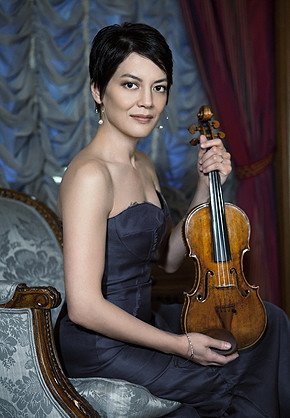Violinist Meyers offers ravishing tone and an eclectic program in Coral Gables

Anne Akiko Meyers performed Thursday night at Coral Gables Congregational Church. Photo: Anne Marie Mazzucco
The violinist Anne Akiko Meyers brought a ravishing tone, a legendary violin and a quirky choice of compositions to a recital Thursday in the beautiful, colonnaded hall of Coral Gables Congregational Church.
Before performing the first work on the program, a Mozart sonata written in 1781, she informed the audience that the violin in her hands had been constructed 40 years before the composition of the sonata. That presumably meant she was performing on a 1741 Guarneri del Gesu that once belonged to the Belgian virtuoso Henri Vieuxtemps. The instrument was on loan to her from an anonymous buyer who paid a reported $16 million for it last year, the highest amount ever paid for a violin.
Mozart’s sonatas for violin and piano may not enjoy quite the same regard as his operas, symphonies and other compositions. But Meyers introduced his Violin Sonata in F Major, K. 377, as “one of Mozart’s greatest works.” Performing with pianist Max Levinson, the violinist made the most of this music, giving a clean, energetic account of the first movement, a high-spirited few minutes that bubbled along on sheer momentum. The heart of the sonata is the second movement, a theme and variations that grows in drama and intensity. She performed the opening minor-key theme in an inward, vulnerable manner and launched into the variations in a way that gave them an almost theatrical drama, without stretching the music beyond 18th-century proportions. Although the finale is less interesting than the preceding movements, she performed it with comparable style and grace.
The concert included two new works described in the program as premieres—except that Meyers’ tour schedule on her web page says the “world premiere” of each will take place next month in Aspen. (In an email, her publicist explained that the Coral Gables performance of each work was a “soft premiere,” with the “official” premiere taking place in Colorado next month.)
Whatever the case, neither work proved particularly interesting on first hearing. Sange, by the Japanese composer Somei Satoh, was inspired by the blessing made around a Buddhist temple. It consisted of almost unbearably slow phrases in the violin, creeping up and down the scale, with occasional swells in volume and intensity, over transparent, mildly dissonant chords in the piano. The contemplative mood was broken by two cell-phone eruptions.
The young American composer Mason Bates, who serves as composer-in-residence to the Chicago Symphony Orchestra, is known for incorporating electronics and other gadgetry into his music. There was none of that in his Suite for Solo Violin. With its broad open-stringed chords, simple harmonic and melodic materials and upbeat style, the work has the feel of an old-fashioned fiddle piece. The three-movement work relies heavily on repetition of not-particularly-interesting motifs. The most striking section takes place in the middle movement, a haunting, ghostly passage, in which Meyers played rapid, pianissimo figures over the accompanying piano melody.
In the first movement of Ravel’s Violin Sonata in G major, Meyers made the most of the long-bowed phrases, playing in a smooth manner that captured the work’s shifting moods of rhapsody and wistfulness. Pianist Levinson caught more of the spirit of the blues-inflected second movement than the violinist, tackling the bouncy rhythms in an improvisatory style full of humor and lightness. Here Meyers played in a manner that was just too literal and uniformly intense, as if she wanted to get every note exactly right. In the virtuosic last movement, she showed what she could do on the instrument, playing the whirl of notes with biting articulation.
Among Meyers’ greatest assets is her tone, built around a vibrato that sounds as natural as a heartbeat, with none of the shrill, forced intensity of other violinists. In two works of tango composer Astor Piazzolla, Milonga del Angel and Oblivion, her timbre—throbbing and sensual on the lowest string, singing and lyric on the highest—gave them a seductive, passionate performance.
As an encore, she offered another work that showed off her violin sound, an arrangement by Makoto Ozone of Harold Arlen’s Somewhere Over the Rainbow.
Posted in Performances
Leave a Comment
Fri Jun 20, 2014
at 12:05 pm
No Comments